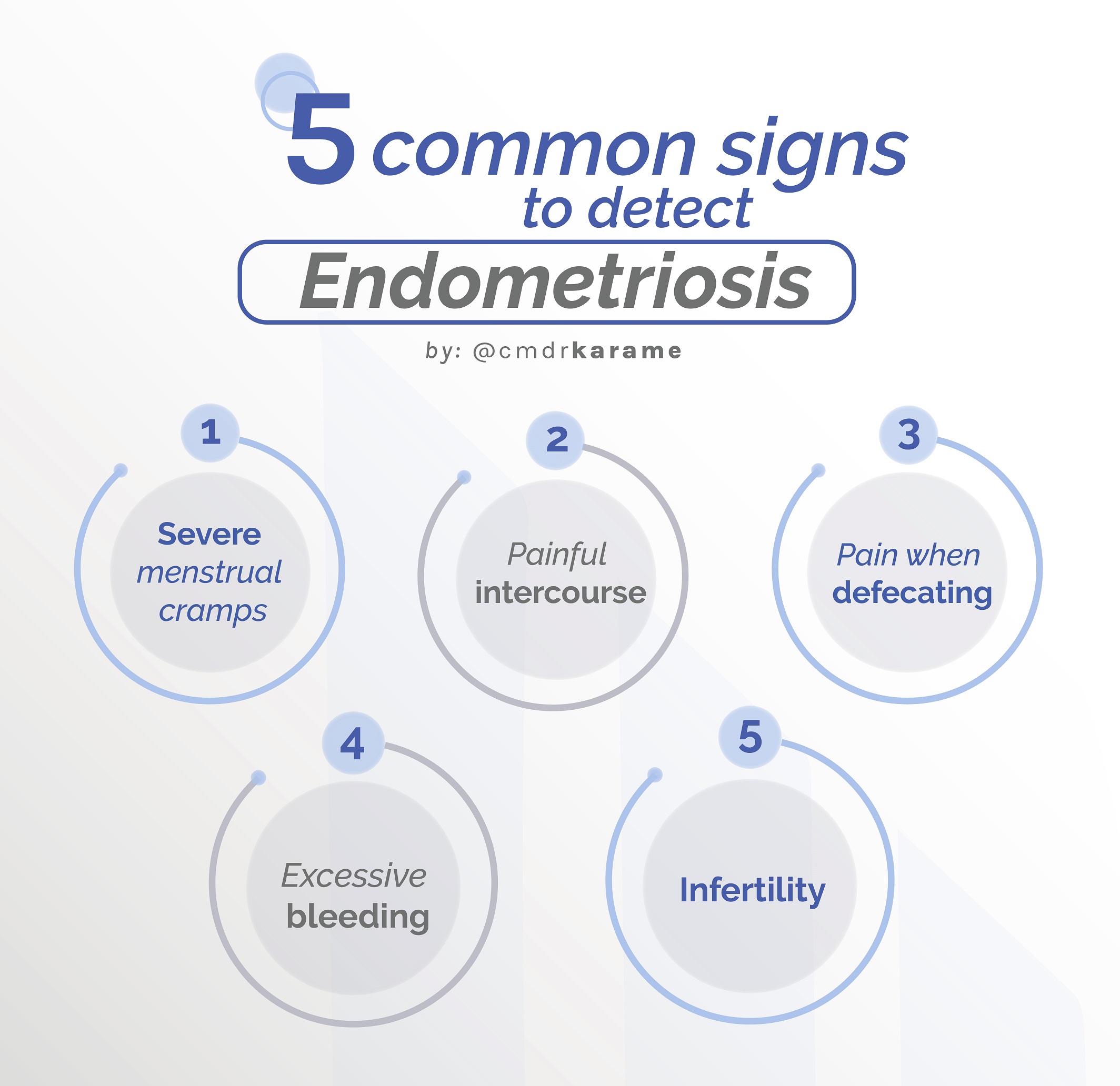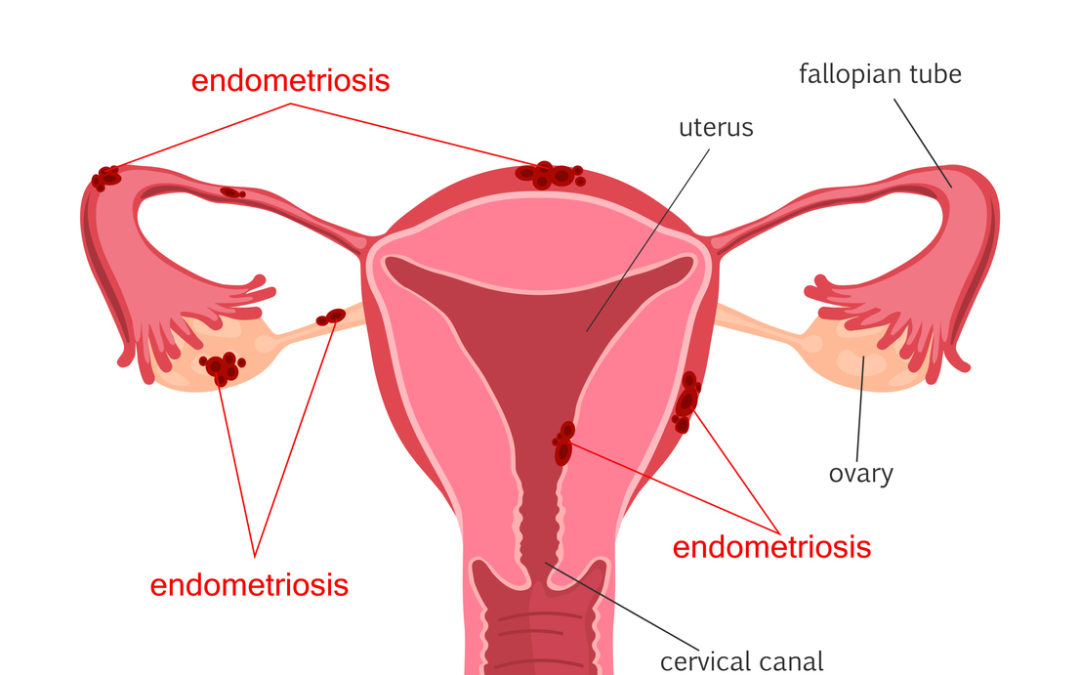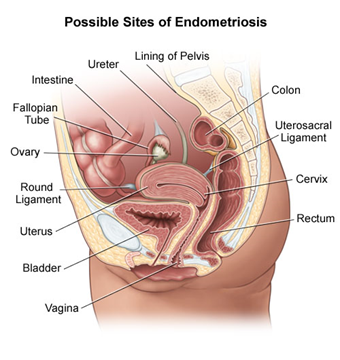Endometriosis Center
What is endometriosis?
Endometriosis is a disease that occurs when small parts of the endometrial tissue (the lining of the uterine cavity) grow into other organs. Common sites of endometriosis are the ovaries, fallopian tubes, the ligaments that support the uterus, the internal area between the rectum and the vagina, the lining of the pelvic and abdominal cavity. It is important to know that this endometrial tissue reacts to hormonal changes during the menstrual cycle, just like the tissue inside the uterus.
It mainly affects women of reproductive age, most of the women diagnosed are between 25 and 35 years old. Endometriosis is more common in Caucasian women than in African-American or Asian women.
Endometriosis symptoms

Patients with endometriosis can attend a consultation with multiple symptoms, the medical history and the physical examination can guide the suspicion of the diagnosis. However, it is important to emphasize that endometriosis can manifest itself in different and unpredictable ways.
It is known that approximately one in three women with endometriosis are asymptomatic. The classic symptoms are dysmenorrhea and pelvic pain that may or may not be accompanied by dyspareunia. But there may be other symptoms such as:
- Pain in the pelvis or in the lower part of the stomach, rectum, vagina and / or lower back.
- Spotting between menstrual cycles.
- Bleeding after intercourse.
- Blood in urine, stool, or other abnormal bleeding.
- Diarrhea and / or constipation.
Endometriosis can induce infertility as a result of anatomical distortion caused by invasive growth and multiple adhesions.

Diagnosis
The gold standard for making the diagnosis of endometriosis is laparoscopy, it is a minimally invasive procedure performed under general anesthesia, it has a good recovery and if there are no complications, the patient can be discharged 24 hours after surgery.
It should be noted that during this procedure, a tissue sample is usually taken to perform a biopsy and thus have the definitive diagnosis.
Pelvic pain
This type of pain appears in the lower abdomen, can be caused by different causes and can even be multifactorial. In women, pelvic pain can be due to changes in the uterus, fallopian tubes, and / or ovaries, as well as in the cervix and vagina. Also pathologies of the urinary tract, colon, rectum and appendix, or affections in the muscles of the pelvic floor, the bones of the pelvis, the tissue that lines the pelvis (peritoneum), and the pelvic nerves.
Some causes of acute pelvic pain are:
- Ectopic pregnancy
- Rupture of an ovarian cyst
- Ovarian torsion
- Tubo-ovarian abscesses due to pelvic inflammatory disease
- Kidney stones
- Appendicitis
- Acute intestinal obstruction
- Pelvic and genitourinary infections
- Stomach flu
Some causes of chronic pelvic pain are:
- Endometriosis
- Adenomyosis
- Pelvic and abdominal adhesions
- Fibroids
- Ovarian cysts
- Pelvic floor dysfunction
- Neuralgias of the pelvic nerves
- Pelvic inflammatory disease
- Interstitial cystitis (painful bladder syndrome)
- Intestinal endometriosis
- Diverticulitis
- Proctitis
- Rectal fissure and hemorrhoids
It is important to see a specialist when there is acute or chronic pelvic pain. With the correct diagnosis and treatment of a pelvic pain specialist, the quality of life of patients can be restored. Timely intervention can avoid fertility alterations and many years of unnecessary suffering and other cases can even prevent disease progression and associated complications and sequelae.
If the pain is suspected to be gynecologic in origin, a complete pelvic exam should be performed. Which is usually accompanied by a transvaginal ultrasound and / or an abdominal ultrasound. In order to diagnose and find the cause of gynecological pelvic pain, invasive procedures may also be required, such as hysteroscopy (insertion of a camera into the uterus) and laparoscopy (insertion of a camera into the pelvis through the navel).
Diagnosing and treating pelvic pain can be complex and requires a lot of experience on the part of specialists, since there is a wide range of treatments and therapies to provide personalized attention to each patient.
Surgical Treatment of Endometriosis
There are two types of behavior regarding endometriosis, medical management and surgical management.
The goal of medical treatment is to induce atrophy of endometrial tissue outside the uterine cavity. It is obtained through the hormonal alteration of the menstrual cycle with the suppression of estrogen synthesis by means of oral contraceptives and generating a state of pseudomenopause with the use of gonadotropin-releasing hormone (GnRh) agonists.
Surgical treatment is the treatment of choice to perform in all the different locations of endometriosis and whatever the manifestation of the disease, since it is the only method capable of producing the elimination of endometriotic lesions.
Two forms of surgical management can be considered, one conservative and the other radical.
The purpose of conservative treatment is to preserve the integrity of the reproductive system, trying to eliminate as many foci, nodules and endometriotic plaques as possible, resect ovarian endometriomas, and release adhesions that compromise some function.
Radical treatment, if convenient and indicated in the patient, may imply sterility when removing the 2 ovaries, it can be complemented with a hysterectomy and / or a bilateral salpingo-oophorectomy. This procedure is usually indicated in patients whose painful symptoms do not yield to any type of treatment. Surgical access is by laparoscopy or if laparotomy is indicated, but it is not the first choice.
Specific indications for laparoscopic surgery include
- Chronic pelvic pain
- Presence of endometriosis
- Presence of endometrioma
- Pelvic adhesions
- Obstruction of the uterine tube
- Infertility
The different procedures during laparoscopy are:
Endometriosis Ablation and Excision
Endometriotic lesions (implants of endometrial tissue that lie outside the endometrium) can be excised (tissue removed) using bipolar or monopolar energy.
Vaporization and fulguration of endometriosis
Endometriotic implants can be burned through a shock wave with bipolar or monopolar energy.
Drainage and Exceresis of the endometrioma capsule
Endometrioma is a special type of ovarian cyst, which occurs due to the growth of ectopic endometrial tissue deposited on its surface that progressively invaginates the ovarian cortex.
The ideal is to remove the endometrioma capsule (capsule excision), but there are cases, where some factors, for example the size of the endometrioma, the presence of multiple adhesions and excessive bleeding, where only the cyst drainage is used.
Presacral Neurectomy (NPS)
This pelvic denervation technique tends to improve up to 70% of patients operated on for dysmenorrhea (pain with menstruation).
This procedure consists of sectioning the fibers of the superior hypogastric plexus, near the fourth and fifth lumbar vertebrae.
Its indications are in women with chronic pelvic pain of central perception, especially intractable dysmenorrhea, in which a relief rate of 65% to 89% is obtained.
Laparoscopic Ablation and Lysis of the Uterosacral Nerve (LUNA)
To confirm or rule out the study of a patient with chronic pelvic pain, the ideal approach is by laparoscopy.
The LUNA is a therapeutic measure for patients with chronic pelvic pain (CPP).
Pain impulses from the uterus, cervix, and proximal fallopian tubes pass through nerve fibers arising in the paracervical plexus of Frankenhauser, at the base of the uterosacral ligaments, and traverse the upper and lower portions of the hypogastric plexus.
Its objective is to section the uterosacral ligaments in their proximal portion approximately 0.5-1 cm from their insertion site in the uterus, laparoscopically using bipolar coagulation.
It is indicated in women with centrally perceived CPD where a relief rate between 63% and 81% is achieved, however this rate decreases markedly after 6 to 12 months to 51%.
Treatment of deep endometriosis
The treatment of deep endometriosis depends on each case, depending on the degree of depth and its extension, the patient must be evaluated by a multidisciplinary team depending on the affected organ. Treatment is based on radical surgery, this means that the affected portion of the organ where the injury is located must be removed or, failing that, the entire organ must be removed.


